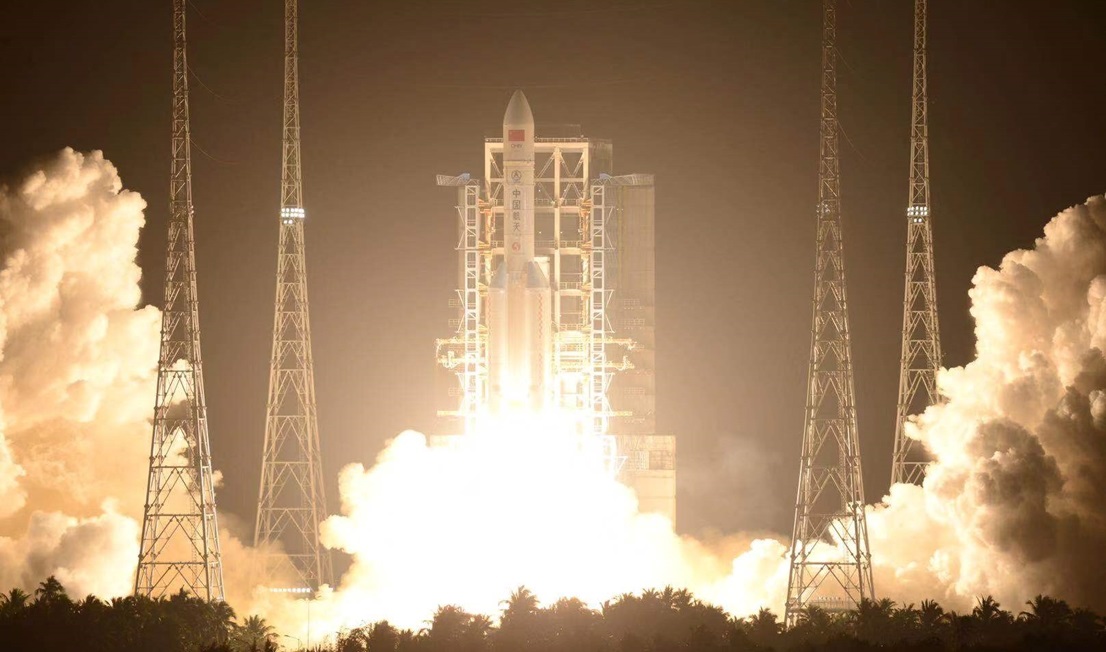China's Huge Long March 5 Rocket Returns to Flight in Dazzling Nighttime Launch
It's the third Long March 5 ever to fly.
China's biggest rocket, the Long March 5, returned to flight for the first time since a 2017 failure Friday (Dec. 27) in a dazzling nighttime launch for the Chinese space program.
The Long March 5 Y3 rocket lifted off at 8:45 p.m. Beijing Time carrying the experimental Shijian 20 communications satellite into a geosynchronous orbit. The satellite, which weighs a reported 8 metric tons, is China's heaviest and most advanced satellite to date, according to state media reports.
The successful launch is the first Long March 5 since a first-stage booster failure in 2017 destroyed the Shijian 18 satellite. The failure prompted redesigns in the rocket's first-stage engines, which led to a two-year gap between missions. The first Long March 5 rocket lifted off in 2016.
Video: Watch China's Long March 5 Return to Space in Stunning Launch
More: This is the 1st Photo of China's Mars Explorer Launching in 2020
The Long March 5 is an essential booster for China's space ambitions. The heavy-lift booster will be the one to launch China's space station modules into orbit, as well as a Mars lander in 2020 and the Chang'e 5 moon sample-return mission.
China is also expected to use a version of the Long March 5, called the Long March 5B, to launch a new crewed spacecraft — the successor to its current Shenzhou crew capsule.
The rocket stands 184 feet (56 meters) tall and weighs nearly 2 million lbs. (867,000 kilograms) at liftoff. It is capable of carrying payloads of up to 55,000 lbs. (25,000 kilograms) into low Earth orbit. It can haul up 31,000 lbs. (14,000 kg) to a higher geostationary transfer orbit.
Breaking space news, the latest updates on rocket launches, skywatching events and more!
The Shijian 20 satellite (its name means "Practice") is designed to be a high-throughput communications satellite "capable of delivering 1 Tbps [1 terabute per second] bandwidth for ultrafast speeds," Chinese space officials said according to the state-run Xinhua news agency.
Shijian 20 is also expected to test a laser communications payload for future missions, as well as new ion thrusters for propulsion.
- Chang'e 4 in Pictures: China's Mission to the Moon's Far Side
- This Is China's New Spacecraft to Take Astronauts to the Moon (Photos)
- China Eyes Robotic Outpost at the Moon's South Pole in Late 2020s
Email Tariq Malik at tmalik@space.com or follow him @tariqjmalik. Follow us @Spacedotcom, Facebook and Instagram.


Tariq is the award-winning Editor-in-Chief of Space.com and joined the team in 2001. He covers human spaceflight, as well as skywatching and entertainment. He became Space.com's Editor-in-Chief in 2019. Before joining Space.com, Tariq was a staff reporter for The Los Angeles Times covering education and city beats in La Habra, Fullerton and Huntington Beach. He's a recipient of the 2022 Harry Kolcum Award for excellence in space reporting and the 2025 Space Pioneer Award from the National Space Society. He is an Eagle Scout and Space Camp alum with journalism degrees from the USC and NYU. You can find Tariq at Space.com and as the co-host to the This Week In Space podcast on the TWiT network. To see his latest project, you can follow Tariq on Twitter @tariqjmalik.

